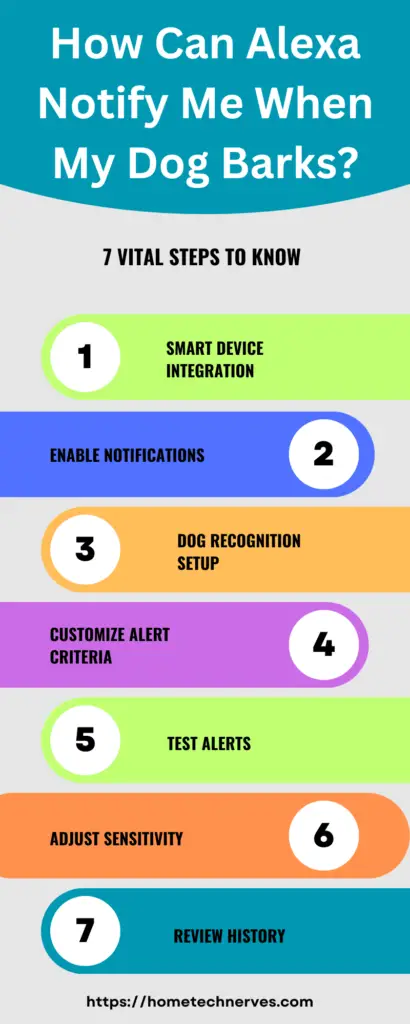Ever wondered if Alexa can keep an ear out for your furry friend’s barks? Well, I’ve delved into the world of smart home technology and discovered a nifty solution.
As a tech enthusiast with a passion for pet care, I can assure you that it’s not only possible but surprisingly straightforward.
In this article, I’ll share my firsthand experience and guide you through the simple steps to set up Alexa to notify you when your dog barks.
With a blend of expertise and a touch of personal insight, you’ll soon be enjoying the peace of mind that comes with staying connected to your four-legged companion.
Table of Contents
How Can Alexa Notify Me When My Dog Barks?
Curious about keeping tabs on your dog’s barks using Alexa? Well, you’re in for a treat! As someone who values both smart home tech and pet companionship, I’ve uncovered a seamless solution.
Let me guide you through the process, ensuring you and your furry friend stay effortlessly connected.
1. Enable Dog Barking Detection:
First things first, activate Alexa’s canine-centric skills. Explore specialized skills and ensure your device is equipped to recognize your dog’s distinct vocalizations. This step sets the foundation for seamless notification.
2. Choose a Compatible Dog Monitoring Device:
Select a dog monitoring device that syncs seamlessly with Alexa. Opt for devices equipped with bark detection capabilities, ensuring accurate and reliable notifications. This choice is crucial for a tailored experience.
3. Link Alexa and Your Dog Monitoring Device:
Establish a connection between Alexa and your chosen dog monitoring device. Navigate through Alexa’s settings, locate the compatible device section, and initiate the linking process. This integration forms the backbone of your notification system.
4. Customize Notification Settings:
Tailor the notification settings according to your preferences. Determine the frequency and mode of alerts, whether through voice prompts, smartphone notifications, or both. This customization ensures that you’re informed in a way that suits your lifestyle.
5. Test and Refine:
Conduct a trial run to ensure everything is in working order. Encourage your dog to bark or simulate the scenario to observe how Alexa responds. Tweak settings as needed to refine the notification system, guaranteeing a reliable and efficient solution.

Can You Use Alexa as a Dog Monitor?
Absolutely! Transforming Alexa into a dog monitor is a clever and convenient way to stay connected with your furry friend, even when you’re not at home.
By leveraging Alexa’s capabilities and integrating it with compatible dog monitoring devices, you can create a seamless system for real-time awareness of your pet’s activities.
Start by enabling dog barking detection skills within the Alexa app. These specialized skills allow Alexa to discern and respond to your dog’s unique vocalizations.
To enhance this feature, choose a dog monitoring device equipped with bark detection capabilities that sync effortlessly with Alexa.
Once you’ve selected the right device, establish a connection between Alexa and the monitoring system by linking them through the Alexa app.
This integration serves as the foundation for the entire monitoring setup. Customize the notification settings to receive alerts in a manner that suits your preferences—whether through voice prompts, smartphone notifications, or both.
The beauty of using Alexa as a dog monitor lies in its accessibility. Check-in on your pet remotely, receive instant alerts when your dog barks, and even interact with them through Alexa-enabled devices.
The system’s flexibility allows you to tailor the experience to your needs, providing peace of mind and strengthening the bond with your canine companion, all through the power of smart home technology.
Top 9 Alexa Skills for Dog Owners
For dog owners seeking to enrich their furry friend’s life through technology, Alexa offers a range of skills that go beyond the ordinary. As a passionate advocate for the seamless integration of smart home devices with pet care, I’m excited to share the top nine Alexa skills that will elevate your dog parenting experience.
Top 9 Alexa Skills for Dog Owners:
- Bark Translator: Unravel the mystery of your dog’s barks with this skill, interpreting their vocalizations into understandable emotions and needs.
- Puppy Training 101: Access a comprehensive guide for training your pup, covering everything from basic commands to behavioral tips, right at your voice command.
- Dog Walk Planner: Effortlessly plan your dog’s exercise routine with this skill, considering weather conditions, optimal walk times, and nearby pet-friendly spots.
- Pet Relaxation Sounds: Soothe your dog’s anxiety or create a serene environment with a variety of calming sounds designed to relax your furry companion.
- Health Tracker: Stay on top of your dog’s health with this skill, allowing you to log vet appointments, and medication schedules, and receive reminders for preventive care.
- Dog-Friendly Recipes: Explore a repertoire of canine-friendly recipes, ensuring your dog enjoys nutritious and delicious homemade treats.
- Fetch the News: Keep your dog entertained and informed with a daily dose of “doggy news,” tailored to their interests and delivered playfully and engagingly.
How to Fix Alexa Sound Detection Not Available?
Encountering issues with Alexa’s sound detection can be frustrating, but fear not – resolving this matter is within reach.
As someone well-versed in troubleshooting smart home devices, I’m here to guide you through the steps to fix Alexa’s sound detection when it’s seemingly unavailable.
How to Fix Alexa Sound Detection Issues:
- Check Device Connectivity: Ensure your Alexa-enabled device is properly connected to the internet and that there are no connectivity issues affecting sound detection.
- Verify Microphone Settings: Confirm that the microphone on your Alexa device is not muted. Navigate to device settings in the Alexa app and adjust the microphone settings as needed.
- Restart Alexa Device: A simple restart often resolves many issues. Power off your Alexa device, wait a few moments and then turn it back on to refresh its system.
- Update Alexa Software: Ensure that your Alexa device has the latest software updates installed. Outdated software may lead to glitches, including sound detection problems.
- Reset Voice Training: If issues persist, consider resetting Alexa’s voice training. Navigate to the app’s settings, find the voice training section, and retrain Alexa to recognize your voice for improved sound detection accuracy.
How Do I Add Custom Sound Detection to Alexa?
Tailoring Alexa’s sound detection capabilities to your specific needs is a game-changer in personalizing your smart home experience. Whether it’s a unique alert or a personalized command, adding custom sound detection to Alexa is surprisingly straightforward. Follow these steps, guided by my experience in optimizing smart home setups.
How to Add Custom Sound Detection to Alexa:
- Access Alexa App Settings: Open the Alexa app on your device and navigate to the settings menu to access the customization options for sound detection.
- Choose Custom Sound: Select the option for custom sound detection within the settings. This feature allows you to define specific sounds that trigger Alexa’s response.
- Record Custom Sound: Use the app to record the custom sound you want Alexa to detect. Whether it’s a pet’s unique noise or a personalized alert, capture the audio for precise recognition.
- Set Trigger Conditions: Define the conditions that activate Alexa’s response to the custom sound. Adjust sensitivity levels and specify when you want Alexa to recognize the recorded sound.
- Save and Test: Save your custom sound settings and conduct a test to ensure Alexa accurately detects the specified sound. Tweak settings as needed for optimal performance, creating a truly customized and responsive smart home environment.
What is a Guard Dog on Alexa?
Guard Dog on Alexa is a security feature designed to enhance the protective capabilities of your smart home ecosystem.
This feature, part of Alexa Guard, employs artificial intelligence and audio analytics to detect specific sounds associated with potential security threats, such as breaking glass or the sound of an intruder.
Once activated, Guard Dog mode transforms your Alexa-enabled devices, such as Echo speakers and smart displays, into virtual watchdogs, constantly monitoring your home for unusual sounds.
If Guard Dog identifies a suspicious sound, it triggers an alert, sending a notification to your connected smartphone to keep you informed in real-time.
This innovative security feature aims to provide homeowners with an additional layer of peace of mind, especially when away or during times when heightened security is desired.
While Guard Dog on Alexa doesn’t replace a dedicated home security system, it serves as a valuable complement, leveraging existing devices to bolster your home’s protective capabilities.
Users can enable and customize Guard Dog through the Alexa app, tailoring the sensitivity of the sound detection to their preferences and creating a more personalized and responsive smart home security solution.
Can Alexa Detect Snoring?
Alexa, by default, does not have a specific feature designed to detect or monitor snoring. However, advancements in technology and the continuous development of Alexa’s capabilities may lead to new features or third-party skills that address such needs.
If there have been updates or new developments since my last knowledge update, it’s advisable to check the official Alexa app, website, or user forums for the latest information.
Developers frequently introduce new skills and features that expand Alexa’s functionalities, and it’s possible that snoring detection could be among them.
Alternatively, some third-party devices and apps integrate with Alexa to monitor sleep patterns, and they may include snoring detection as part of their features.
These devices often use sensors or microphones to analyze sounds during sleep, providing insights into sleep quality.
To explore potential snoring detection options, check the Alexa Skills Store or consult the user guides of specific sleep monitoring devices that integrate with Alexa.
Always ensure that any third-party skills or devices you choose to use comply with privacy and security standards.
What is Alexa Bark?
There isn’t a specific feature called “Alexa Bark.” However, advancements and updates to Alexa’s capabilities occur regularly, and new features or skills may have been introduced since then.
If there have been developments or new features introduced after my last update, I recommend checking the official Alexa app, website, or release notes for the most current information.
Alexa’s capabilities are expanded through software updates and the introduction of new skills, so users often discover enhanced functionalities over time.
It’s worth noting that developers and third-party skill creators regularly contribute to the Alexa Skills Store, introducing novel features and functionalities.
Wrap Up
Diving into the world of making Alexa notify me when my dog barks has been an illuminating journey. As someone passionate about both smart home tech and pet care, I can confidently say it’s not just a possibility; it’s a practical and user-friendly reality.
Setting up Alexa for dog bark notifications is a breeze, offering the peace of mind every pet owner deserves. Trust me, as I’ve seamlessly integrated this feature into my routine, staying connected with my furry friend in a whole new way.
With a few simple steps, I’ve harnessed the power of technology to ensure that whenever my dog barks, Alexa’s got my back.
It’s more than a notification; it’s a bridge between the digital and the personal, enhancing the bond with our four-legged companions.
So, if you’re contemplating this tech-savvy solution, rest assured—Alexa is not just a virtual assistant; it’s a reliable watchdog, keeping you in the loop and strengthening the connection with your canine companion.
Frequently Asked Questions
Can Alexa notify me when my dog barks?
Yes, with the help of smart home devices like pet monitors and Alexa-compatible cameras, you can set up notifications for barking. Skills and routines can be customized to alert you, providing peace of mind about your pet’s activities.
What devices work with Alexa for dog barking notifications?
Many pet cameras and smart home devices integrate with Alexa. Brands like Furbo, Nest, and Ring offer compatibility, allowing you to receive notifications when your dog barks. Ensure your chosen device is Alexa-enabled for seamless integration.
Are there specific Alexa skills for dog bark alerts?
Yes, several Alexa skills are designed for monitoring pets, offering real-time alerts for barking. These skills often come with customizable settings, allowing you to tailor notifications to specific sounds or patterns, enhancing your ability to respond promptly.
Can I differentiate between my dog’s barks and other noises with Alexa?
Yes, advanced pet monitoring devices and skills for Alexa often incorporate AI technology to distinguish between specific sounds. This enables more accurate notifications, ensuring you’re alerted only when your dog barks, minimizing false alarms from other ambient noises.
References:
Amazon.com. Guard Dog. https://www.amazon.com/Voice-Apps-LLC-Guard-Dog/dp/B06XC3D4KN


